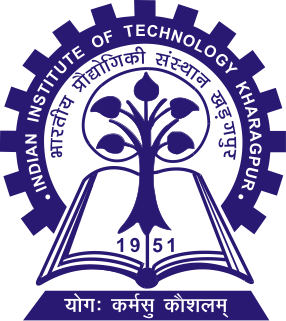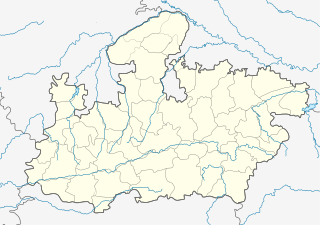
The Gondi (Gōndi) or Gond people are an Adivasi group of India that speak Gondi language which is a Dravidian language and are listed as a Scheduled Tribe for the purpose of India's system of positive discrimination. They are spread over the states of Madhya Pradesh, eastern Maharashtra (Vidarbha), Chhattisgarh, Uttar Pradesh, Telangana, Andhra Pradesh, Bihar and Odisha.

Bhils or Bheels are an Indo-Aryan speaking ethnic group in West India. They speak the Bhil languages, a subgroup of the Western Zone of the Indo-Aryan languages. As of 2013, Bhils were the largest tribal group in India.

Madhya Pradesh is a state of India. Music from the area includes rural folk and tribal music, ceremonial and ritual music and Indian classical music. Unlike in many parts of India, the people of Madhya Pradesh place few restrictions on who can sing which songs. With the exception of some ritualistic works, people sing songs from across ethnic and racial boundaries.
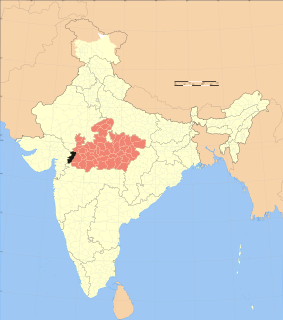
Jhabua is a district of Madhya Pradesh state in central India. The town of Jhabua is the administrative headquarters of the district.
India's tribal belt refers to contiguous areas of settlement of tribal people of India, that is, groups or tribes that remained genetically homogenous as opposed to other population groups that mixed widely within the Indian subcontinent. The tribal population in India, although a small minority, represents an enormous diversity of groups. They vary in language and linguistic traits, ecological settings in which they live, physical features, size of the population, the extent of acculturation, dominant modes of making a livelihood, level of development and social stratification. They are also spread over the length and breadth of the country though their geographical distribution is far from uniform. A majority of the Scheduled Tribe population is concentrated in the eastern, central and western belt covering the nine States of Odisha, Madhya Pradesh, Chhattisgarh, Jharkhand, Maharashtra, Gujarat, Rajasthan, Andhra Pradesh and West Bengal. About 12 percent inhabit the North-eastern region, about five percent in the Southern region and about three percent in the Northern States.

Faggan Singh Kulaste is an Indian politician and a member of the Bharatiya Janata Party (BJP). He was sworn in as Union Minister of State in the Ministry of Steel on 30 May 2019 under Prime Minister Narendra Modi. Kulaste is elected as a member of the 17th Lok Sabha (2019–2024). He represents the Mandla constituency of Madhya Pradesh. He was also Minister of State in Modi government. He has previously been a member of the 11th, 12th, 13th, 14th and 16th Lok Sabha.

There are 46 recognized Scheduled Tribes in Madhya Pradesh, India, three of which have been identified as 'Particularly Vulnerable Tribal Groups (PTGs)(formerly known as 'Special Primitive Tribal Groups'). The population of Scheduled Tribals (ST) is 21.1% of the state population, according to the 2011 census. Bounded by the Narmada River to the north and the Godavari River to the southeast, tribal peoples occupy the slopes of the region's mountains.
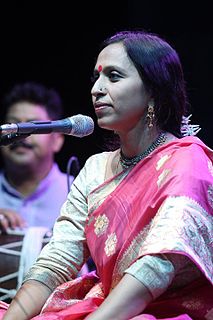
Vidya Shah is an Indian singer, musician, social activist and writer.
Bharatiya Grameen Mahila Sangh or BGMS, founded in 1955, is a non-political and non-sectarian national organization with branches all over India, in 14 states and union territories. It is affiliated with the Associated Country Women of the World (ACWW), the world's largest organization for rural women, which in turn is a consultative body for UNO, UNESCO, WHO, and ILO.
Nikhil Dey is an Indian social activist. He works for the MKSS, Suchna Evum Rozgar Adhikar Abhiyan and NCPRI. He has been actively working for Right to Information, Mahatma Gandhi National Rural Employment Guarantee Act, Lokpal bill and Right to Food and other Human Rights organisations.
National Alliance of People's Movements is an alliance of progressive people's organizations and movements in India. It is an umbrella organisation for a larger alliance integrating various civil society organisations and individuals working towards similar goals.
Mama Baleshwar Dayal was a social worker and socialist politician from India. He is remembered for his work among the Bhil tribes of Rajasthan and Madhya Pradesh whom he organised to fight for their rights to jal, jungle aur jameen.
Kunwar Singh Tekam is the Bharatiya Janata Party Member of the Madhya Pradesh Legislative Assembly for Dhauhani constituency in Sidhi district. He gained 60704 (54.58%) votes in the 2008 election He gained 60130 votes in the 2013 election.
Krantikari Adivasi Mahila Sangathan is a banned women's organisation based in India. The Krantikari Adivasi Mahila Sangathan (KAMS) is a successor of the Adivasi Mahila Sanghathana (AMS). The foundation of the AMS was laid by the Maoists in 1986.
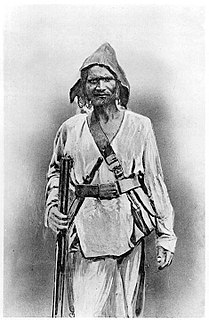
Tantia Bhīl was a dacoit (bandit) active in British India between 1878 and 1889. He is described very negatively as a criminal in period British accounts, but is recognized by Indians as a heroic figure. Accounts of both eras have described him as an Indian "Robin Hood".
Bhuri Bai is an Indian Bhil artist. Born in Pitol village of Jhabua district in Madhya Pradesh, Bhuri Bai belongs to the community of Bhils, the largest tribal group of India. She has won many awards including the highest state honour accorded to artists by the Madhya Pradesh government, the Shikhar Samman.

Lado Bai is a tribal artist from the Bhil tribe of Madhya Pradesh. Her work has been showcased in various exhibitions in India, France and the UK.
Survival Edge Technology is a term coined by social activist Rahul Banerjee to depict the assortment of simple technologies that can be implemented by communities through collective action to mitigate the agriculture, water, energy and climate crises that face humanity.




